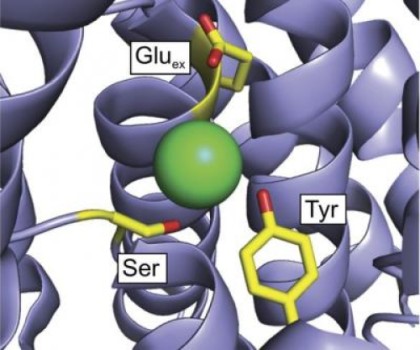
He’s not a dentist, but Christopher Miller is focused on fluoride. Two studies from his Brandeis University lab provide new insights into the mechanisms that allow bacteria to resist fluoride toxicity, information that could eventually help inform new strategies for treating harmful bacterial diseases.
The studies appear in The Journal of General Physiology (JGP).
Although most animal cells are protected from direct exposure to fluoride, this toxic element is a serious threat to single-celled organisms like bacteria and yeast. As a result, their plasma membranes carry two different types of proteins to help rid the cell of unwanted fluoride: fluoride/hydrogen antiporters use energy to actively pump fluoride “uphill” out of the cell; and fluoride-specific “Fluc” ion channels mediate the passive “downhill” movement of fluoride across the cell membrane.
Fluc channels were first identified by Miller and colleagues very recently, in 2013. In the September issue of JGP, they now provide the first quantitative data demonstrating how these passive channels can help protect bacteria from fluoride. The authors found that fluoride accumulates in E. coli lacking Fluc when the external environment is acidic. In such acidic environments, fluoride enters the cell in the form of HF (hydrofluoric acid) — which easily permeates the membrane — and breaks down in the cell’s lower acidity; Fluc provides a means of escape for the highly charged fluoride ions. They also found that bacteria proliferation was stalled by high fluoride exposure, indicating that targeting Fluc channels with antibiotics could be an effective way to slow bacterial growth.
In the August issue of JGP, Miller and colleagues unearthed new information about fluoride/hydrogen antiporters — also recently discovered — which are part of the CLC superfamily of proteins that are known for exporting chloride. The authors explored why this subset demonstrates higher selectivity for fluoride — which is essential for their function because chloride is so much more abundant in the environment — and were able to determine key structural differences that could account for the preferential selectivity of fluoride.
Story Source:
The above story is based on materials provided by The Rockefeller University Press. Note: Materials may be edited for content and length.
Journal References:
- C. Ji, R. B. Stockbridge, C. Miller. Bacterial fluoride resistance, Fluc channels, and the weak acid accumulation effect. The Journal of General Physiology, 2014; 144 (3): 257 DOI: 10.1085/jgp.201411243
- A. E. Brammer, R. B. Stockbridge, C. Miller. F-/Cl- selectivity in CLCF-type F-/H antiporters. The Journal of General Physiology, 2014; 144 (2): 129 DOI: 10.1085/jgp.201411225
